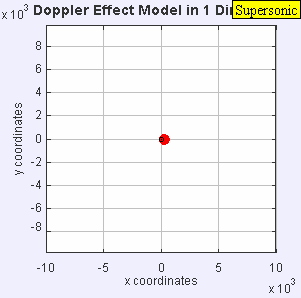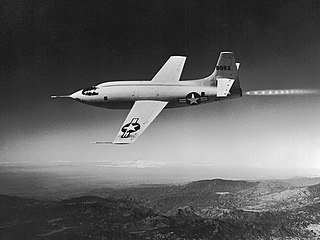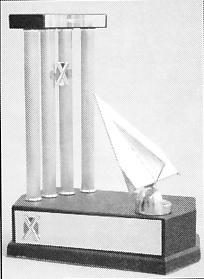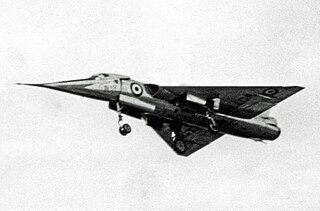
The Aérospatiale/BAC Concorde is a British–French turbojet-powered supersonic passenger airliner that was operated from 1976 until 2003. It had a maximum speed over twice the speed of sound, at Mach 2.04, with seating for 92 to 128 passengers. First flown in 1969, Concorde entered service in 1976 and operated for 27 years. It is one of only two supersonic transports to have been operated commercially; the other is the Soviet-built Tupolev Tu-144, which operated in the late 1970s.

The Tupolev Tu-144 is a Soviet supersonic passenger airliner designed by Tupolev in operation from 1968 to 1999.

A sonic boom is a sound associated with shock waves created when an object travels through the air faster than the speed of sound. Sonic booms generate enormous amounts of sound energy, sounding similar to an explosion or a thunderclap to the human ear. The crack of a supersonic bullet passing overhead or the crack of a bullwhip are examples of a sonic boom in miniature.

The Bell X-1 is a rocket engine–powered aircraft, designated originally as the XS-1, and was a joint National Advisory Committee for Aeronautics–U.S. Army Air Forces–U.S. Air Force supersonic research project built by Bell Aircraft. Conceived during 1944 and designed and built in 1945, it achieved a speed of nearly 1,000 miles per hour in 1948. A derivative of this same design, the Bell X-1A, having greater fuel capacity and hence longer rocket burning time, exceeded 1,600 miles per hour in 1954. The X-1, piloted by Chuck Yeager, was the first manned airplane to exceed the speed of sound in level flight and was the first of the X-planes, a series of American experimental rocket planes designed for testing new technologies.

A supersonic transport (SST) or a supersonic airliner is a civilian supersonic aircraft designed to transport passengers at speeds greater than the speed of sound. To date, the only SSTs to see regular service have been Concorde and the Tupolev Tu-144. The last passenger flight of the Tu-144 was in June 1978 and it was last flown in 1999 by NASA. Concorde's last commercial flight was in October 2003, with a November 26, 2003 ferry flight being its last airborne operation. Following the permanent cessation of flying by Concorde, there are no remaining SSTs in commercial service. Several companies have each proposed a supersonic business jet, which may bring supersonic transport back again.

A head-up display, also known as a HUD, is any transparent display that presents data without requiring users to look away from their usual viewpoints. The origin of the name stems from a pilot being able to view information with the head positioned "up" and looking forward, instead of angled down looking at lower instruments. A HUD also has the advantage that the pilot's eyes do not need to refocus to view the outside after looking at the optically nearer instruments.

A glass cockpit is an aircraft cockpit that features electronic (digital) flight instrument displays, typically large LCD screens, rather than the traditional style of analog dials and gauges. While a traditional cockpit relies on numerous mechanical gauges to display information, a glass cockpit uses several multi-function displays driven by flight management systems, that can be adjusted to display flight information as needed. This simplifies aircraft operation and navigation and allows pilots to focus only on the most pertinent information. They are also popular with airline companies as they usually eliminate the need for a flight engineer, saving costs. In recent years the technology has also become widely available in small aircraft.

Elevons or tailerons are aircraft control surfaces that combine the functions of the elevator and the aileron, hence the name. They are frequently used on tailless aircraft such as flying wings. An elevon that is not part of the main wing, but instead is a separate tail surface, is a stabilator.
Gulfstream Aerospace Corporation is an American aircraft company and a wholly owned subsidiary of General Dynamics. Gulfstream designs, develops, manufactures, markets, and services business jet aircraft. Gulfstream has produced more than 2,000 aircraft since 1958. Gulfstream's current range consists of the G280, G550, G500/G600, and G650/G650ER/G700.

The Bristol 188 is a British supersonic research aircraft built by the Bristol Aeroplane Company in the 1950s. Its length, slender cross-section and intended purpose led to its being nicknamed the "Flaming Pencil".

The Iven C. Kincheloe Award recognizes outstanding professional accomplishment in the conduct of flight testing. It was established in 1958 by the Society of Experimental Test Pilots in memory of test pilot and Korean War ace Iven C. Kincheloe, United States Air Force, who died during flight testing.

The droop nose or drooped nose is a feature that a handful of aircraft, the majority of these being also equipped with delta wings and capable of supersonic speeds, have been fitted with.

The Shuttle Training Aircraft (STA) was a NASA training vehicle that duplicated the Space Shuttle's approach profile and handling qualities, allowing Space Shuttle pilots to simulate Shuttle landings under controlled conditions before attempting the task on board the orbiter. The STA was also flown to assess weather conditions just prior to Space Shuttle launches and landings.

A supersonic aircraft is an aircraft capable of supersonic flight, which is an aircraft able to fly faster than the speed of sound. Supersonic aircraft were developed in the second half of the twentieth century. Supersonic aircraft have been used for research and military purposes, but only two supersonic aircraft, the Tupolev Tu-144 and the Concorde, ever entered service for civil use as airliners. Fighter jets are the most common example of supersonic aircraft.

A synthetic vision system (SVS) is a computer-mediated reality system for aerial vehicles, that uses 3D to provide pilots with clear and intuitive means of understanding their flying environment.

Quiet Spike was a collaborative program between Gulfstream Aerospace and NASA's Dryden Flight Research Center to investigate the suppression of sonic booms. The patent was published with the United States Patent and Trademark Office in 2004 and is owned by Gulfstream Aerospace.

The High Speed Civil Transport (HSCT), a supersonic airliner, was the focus of the High-Speed Research (HSR) Program, a NASA program to develop the technology needed to design and build a supersonic transport that would be environmentally acceptable and economically feasible. The aircraft was to be a future supersonic passenger aircraft, baselined to cruise at Mach 2.4, or more than twice the speed of sound. The project started in 1990 and ended during 1999. The goal was to employ up-to-date technologies.
The Gulfstream X-54 is a proposed research and demonstration aircraft, under development in the United States by Gulfstream Aerospace for NASA, that is planned for use in sonic boom and supersonic transport research.

An Enhanced flight vision system is an airborne system which provides an image of the scene and displays it to the pilot, in order to provide an image in which the scene and objects in it can be better detected. In other words, an EFVS is a system which provides the pilot with an image which is better than unaided human vision. An EFVS includes imaging sensors such as a color camera, infrared camera or radar, and typically a display for the pilot, which can be a head-mounted display or head-up display. An EFVS may be combined with a synthetic vision system to create a combined vision system.

The Lockheed Martin X-59 QueSST is an American experimental supersonic aircraft being developed at Skunk Works for NASA's Low-Boom Flight Demonstrator program. Preliminary design started in February 2016, with the X-59 scheduled for delivery in late 2021 for flight tests from 2022. It is expected to cruise at Mach 1.42 and 55,000 ft (16,800 m), creating a low 75 Perceived Level decibel (PLdB) thump to evaluate supersonic transport acceptability.

















